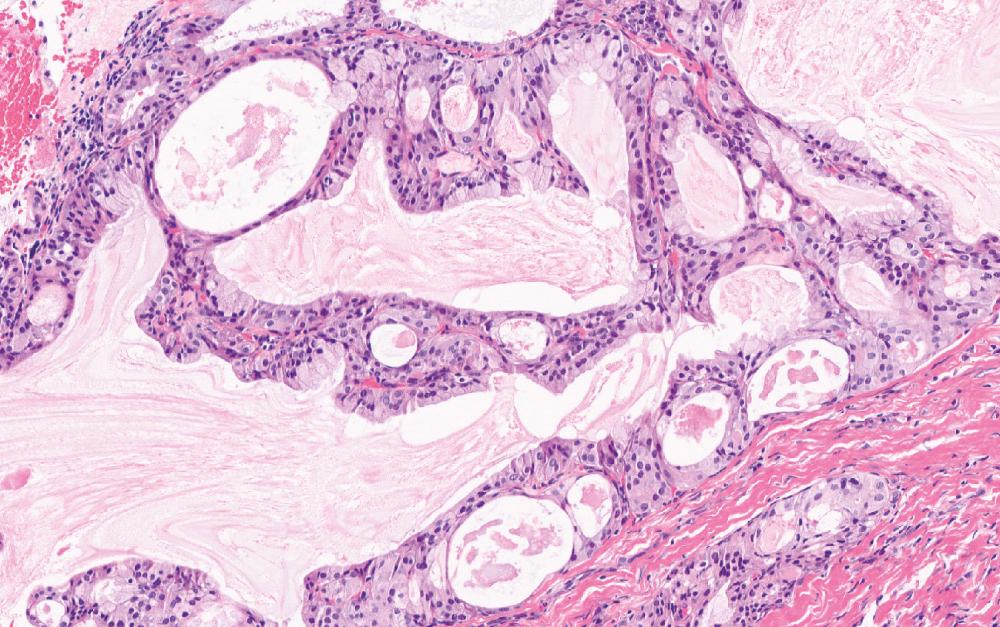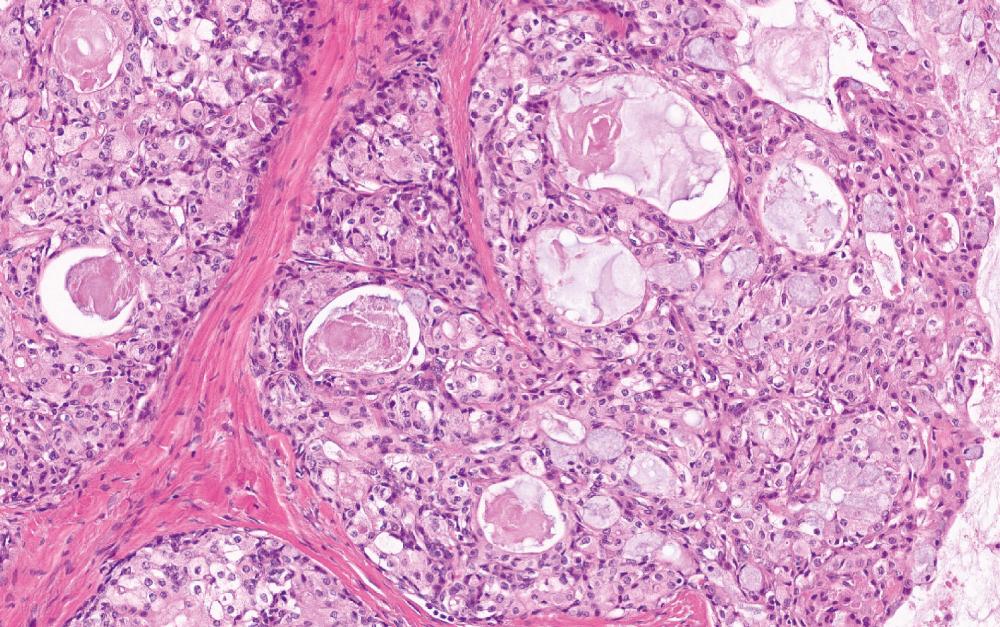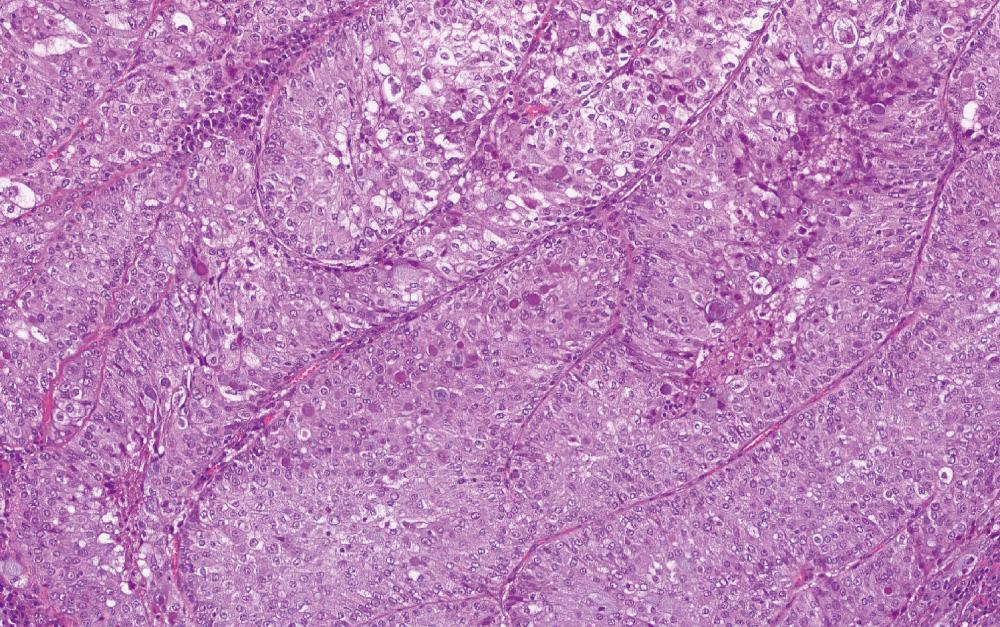Physical Address
304 North Cardinal St.
Dorchester Center, MA 02124
Malignant salivary gland tumors are rare, accounting for <1% of all cancers and 3–5% of head and neck cancers. It encompasses a diverse group of disease entities with heterogeneous histologies and clinical behaviors. Advances in genomic and molecular pathology techniques have improved tumor characterization and expanded our understanding of tumor biology. In addition, classification of salivary gland tumors has recently been updated. In the 4th edition of the World Health Organization (WHO) Classification published in 2017, new entities have been described and added while others have been removed or collapsed into another category. Diagnostic criteria for existing lesions have also been refined and new treatment strategies have emerged. This chapter summarizes contemporary approaches and recent advances in the characterization, diagnosis, and management of malignant salivary gland tumors.
Based on Surveillance, Epidemiology, and End Results (SEER) data, the current age-adjusted incidence rate of salivary gland malignancies in the United States is 1.3 new cases per 100,000. A significant increase in incidence has been reported in recent decades within the US and Europe. Peak incidence typically occurs during the sixth and seventh decades of life. Incidence rate is higher among men than women. Pediatric malignant salivary gland malignancies are extremely rare but the risk of malignancy associated with salivary gland masses is higher in children than in adults.
Salivary gland tumors most commonly arise within the parotid gland. In general, the risk of malignancy is inversely associated with the size of the gland. While 15–32% of parotid tumors are malignant, approximately 41–45% of submandibular, 70–90% of sublingual, and 50% of minor salivary gland tumors are malignant. In addition, malignant salivary gland tumors can arise from ectopic salivary tissues found within head and neck lymph nodes or bones.
The etiology of primary salivary gland malignancies remains largely unknown. However, radiation exposure appears to be a risk factor. For example, a higher incidence of malignant salivary gland tumors has been reported in patients with a history of Hodgkin lymphoma treated with radiotherapy and in patients exposed to radiation from atomic weapons. Occupational exposures to rubber, nickel alloys, silica dust, kerosene, and hair dyes have also been suggested to play a role. Although conflicting data exists, alcohol consumption, smoking, and a diet high in processed meats have been associated with elevated risks of salivary gland malignancy. Moreover, a history of pleomorphic adenoma is associated with a risk of malignant transformation that significantly increases over time. An association between patients with a history of breast cancer and tumors of salivary gland origin has been previously reported. A recent report noted a higher incidence of salivary gland cancers in patients with BRCA mutation.
Sequencing studies have revealed that genomic alterations play an important role in the oncogenesis of salivary gland malignancies. Somatic mutations, chromosomal rearrangements, copy number aberrations, and epigenetic alterations have been identified in a variety of tumor types, including mucoepidermoid carcinoma (MEC), adenoid cystic carcinoma (ACC), salivary duct carcinoma (SDC), hyalinizing clear cell carcinoma (HCCC), carcinoma ex-pleomorphic adenoma, and acinic cell carcinoma. A new entity, mammary analog secretory carcinoma (MASC), has also been recently defined based on a key molecular alteration, t(12;15)(p13;q25) translocation, resulting in ETV6-NTRK3 fusion. Although evidence on targeted therapies in salivary gland malignancies remain limited, recently discovered alterations with potential for therapeutic intervention are discussed in this chapter.
Benign and malignant salivary gland tumors commonly present as painless, slow-growing masses. Minor salivary gland tumors may arise from the oral cavity, palate, paranasal sinuses, nasopharynx, nasal cavity, pharynx, larynx, and trachea. Features suggestive of malignancy include pain, ulceration, rapid growth, facial nerve or other cranial nerve paralysis, paresthesia, fixation to underlying structures, and cervical lymphadenopathy. However, a lack of symptoms does not exclude the possibility of malignancy. Tumors can be asymptomatic and found incidentally on imaging. In advanced tumors, skin involvement and distant metastases can develop. Clinical presentation also depends on anatomic location. For example, involvement of the parapharyngeal space by deep lobe parotid tumors or minor salivary gland tumors can present as an oropharyngeal mass, “hot potato voice”, unilateral eustachian tube obstruction, dysphagia, or obstructive sleep apnea.
Diagnostic work-up should include complete history and physical examination, as well as imaging studies and biopsy. Computed tomography (CT) is readily assessible and can be used to define tumor extent, detect metastatic cervical lymphadenopathy, and assess for cortical bone involvement. In addition to contrast enhanced head and neck CT, a chest CT scan should be considered for high-grade and locally advanced tumors to exclude lung metastases. Magnetic resonance imaging (MRI) is particularly useful for assessing large tumors with deep lobe or parapharyngeal space involvement, for minor salivary gland tumors with submucosal extension, and if perineural invasion is suspected. Positron emission tomography (PET) imaging is not routinely recommended since malignant salivary neoplasms demonstrate variable 18 F fluorodeoxyglucose (FDG) uptake. As such, it cannot be used to reliably detect tumors or to distinguish malignant from benign lesions. While advanced malignancies with invasion of surrounding structures, involvement of cranial nerves, and metastatic disease can be suspected based on physical examination and/or imaging findings, pathologic diagnosis is usually required to distinguish malignant from benign conditions.
Fine needle aspiration biopsy (FNAB) is a well-established diagnostic tool in salivary gland neoplasms. In general, the diagnostic accuracy of FNAB is lower for malignant salivary gland tumors compared with benign and depends greatly on the experience of the cytopathologist. Ultrasound can be used to improve accuracy of FNAB, particularly for necrotic or cystic tumors. The lack of uniform reporting guidelines also contributes to the challenges of cytopathologic diagnosis. Recently, the Milan System for Reporting Salivary Gland Pathology was proposed with goals of facilitating standardized reporting and improving the overall effectiveness of FNAB across institutions. Six categories were defined with associated risks of malignancy. In cases where lymphoma is suspected, core biopsy can be performed, and fresh samples can be sent for flow cytometry. Open biopsies are generally not recommended due to the risks of facial nerve injury, tumor rupture, and seeding. Complete tumor excision (i.e., parotidectomy with facial nerve dissection or submandibular gland excision) can be utilized for cases where a diagnosis is uncertain. Intraoperative frozen section can be considered when an experienced pathologist is available. However, frozen section has a reported accuracy rate of 85.9% for malignant tumors and a false-negative rate of 2.6%.
Treatment approaches for malignant salivary gland neoplasms require individualized approaches and depend on histology, tumor grade, and stage. Primary surgical resection is the standard treatment for resectable carcinomas of the major and minor salivary glands. For advanced and/or high-grade carcinomas, multimodality therapy, including radiotherapy and systemic therapies is required. Mesenchymal-derived malignancies, such as sarcomas, rarely occur in salivary glands and require a multidisciplinary approach. Lymphomas are treated nonsurgically. Metastatic disease involving the parotid gland can occur in cutaneous malignancies, including squamous cell carcinoma and malignant melanoma. While surgical resection is utilized for regional control, treatment algorithms are evolving with expanding investigation of checkpoint inhibitors and targeted therapies in both neoadjuvant and adjuvant settings.
Surgical resection of the primary tumor balances oncologic control and adequate margins with functional preservation. For carcinomas occurring within the superficial lobe of the parotid gland, the treatment of choice is superficial parotidectomy with complete tumor resection with a cuff of normal glandular tissue. Total parotidectomy is indicated for tumors involving or arising within the deep lobe. Radical parotidectomy with sacrifice of the facial nerve is indicated for infiltrative tumors involving or surrounding the facial nerve, particularly in the setting of a preoperative facial nerve paralysis. If facial nerve function is intact preoperatively, every effort should be made to preserve the facial nerve without compromising oncologic outcomes. A guiding surgical principal is to leave no gross disease behind. In the setting of malignancy if the facial nerve is encased in tumor and a plane of dissection cannot be developed to avoid leaving gross disease, the nerve should be resected. For tumors with involvement of the skin, temporal bone, mandible, masticator space, or infratemporal fossa, an extended parotidectomy with reconstruction is indicated. Tumors involving the parapharyngeal space may require a combination of approaches, including transcervical and/or transparotid approaches. Larger tumors or those with close proximity to the carotid artery may require mandibulotomy for access. Transoral approaches are rarely indicated for malignant tumors.
For malignant tumors involving the submandibular gland, excision of the entire gland with level IA and IB contents is advocated over excision of the gland alone, to achieve adequate soft tissue margins and to remove the primary echelon of lymph nodes that might harbor metastatic disease. The marginal mandibular branch of the facial nerve, lingual nerve, and hypoglossal nerve should be identified and preserved unless directly infiltrated by tumor. Sublingual gland tumors should be treated with excision of the entire gland along with the surrounding tissue for margin control. Depending on tumor extent, excision of the submandibular gland, floor of the mouth mucosa, floor of the mouth musculature, and mandible may be required. Lingual and hypoglossal nerves may be preserved if not directly involved by tumor.
Minor salivary gland tumors vary in location. In general, wide local resection with adequate margins is the treatment of choice. The oral cavity and oropharynx are the most commonly involved sites. For malignant tumors involving the palate, maxillectomy may be indicated for bony involvement or to achieve margin control. Soft palate resection can lead to velopharyngeal insufficiency and may require soft tissue or obturator reconstruction. In selected cases with limited disease, tumors involving the oropharynx, nasal cavity/paranasal sinuses, or larynx may be amendable to transoral robotic surgery, endoscopic resection, or conservative laryngeal surgery, respectively. However, advanced tumors generally require an open approach with reconstruction.
Therapeutic neck dissections are performed for cases with clinically positive nodal disease. Levels of the neck dissected depend on locations of the primary tumor and involved nodes. The indications for prophylactic neck dissection are controversial as evidence varies regarding incidence of occult nodal metastases. In general, prophylactic neck dissection for a clinically N0 neck may be advocated for high-grade tumors and locally advanced T3 or T4 disease, or when exposure of the neck is required for reconstructive purposes.
MEC has been reported as the most common malignant tumor of the salivary glands in multiple large retrospective cohorts of children and adults. MEC is associated with a female preponderance with a mean age at presentation of ~45 years. The parotid gland is the most commonly involved major salivary gland, where MEC represents up to 50% of all parotid malignancies. In the minor salivary glands, MEC most commonly occurs on the palate but can be found in a variety of locations including the oral cavity, oropharynx, larynx, nasal cavity, and paranasal sinuses. MECs occurring within the mandible or maxilla, known as central MECs, are thought to arise from heterotopic salivary tissue. Although rare, this disease entity should be included in the differential diagnosis of unicystic or multicystic lesions of the mandible or maxilla. MEC is the salivary gland malignancy most frequently associated with a false-negative frozen section diagnosis. Clinical behavior of MEC ranges from indolent to rapid growth with metastatic spread. Prognosis depends on stage and tumor grade. Advanced stage and high-grade tumors are associated with significantly worse survival outcomes compared with low-grade tumors.
MEC tumors are characterized by the presence of two populations of cells – the mucus cells and the epidermoid cells, the proportion of which helps to define the grade of the tumor. Low-grade MEC is characterized by prominent cystic structures and mature cellular elements. This tumor contains proportionally more mucus cells, which may form gland-like structures, and fewer epidermoid cells ( Fig. 45.1 ). Intermediate-grade tumors display fewer and smaller cysts and occasional solid islands of epidermoid tumor cells. Although mucus cells are still present, there is an increasing proportion of epidermoid cells and occasional keratin pearl formation ( Fig. 45.2 ). The high-grade carcinomas are hypercellular, solid tumors with noticeable cellular atypia and frequent mitotic figures. These tumors will often be mistaken for a squamous cell carcinoma and the differentiation between the two can be quite difficult ( Fig. 45.3 ). Positive immunohistochemical staining for mucin indicates a high-grade MEC rather than a squamous cell carcinoma.



MEC is characterized by frequent and unique translocation that may constitute an initiating event in the development of a subset of these tumors. Several cytogenetic analyses of MEC have shown translocation t(11;19) (q21;p13) either alone or with other nonspecific alterations. Cloning of this translocation has identified a fusion oncogene composed of exon 1 of the MECT1 (CRTC1/WAMTP) gene on chromosome 19p13 and exons 2–5 of the MAML2 gene on chromosome 11q21 regions. MAML2 , a member of the mastermind gene family, encodes a nuclear protein that binds to the CSL transcriptional factor and the intracellular domain of the Notch receptor to activate the Notch target gene. The fusion partner is the CRTC1 (MECT1) , a member of the highly conserved CREß/cAMP coactivator gene family. Studies of this fusion transcript in a series of MEC have reported a correlation between fusion positive tumors and low tumor grade and better behavior. CRTC1/MAML2 translocations are seen in 50–88% of MECs. Fusion-negative MEC may evolve from a different evolutionary pathway and may represent a biologically distinctive category. The results also suggest that tumors lacking the fusion transcript behave more aggressively. In addition to CRTC1/MAML2 translocations, next generation sequencing studies have also identified frequent mutations in TP53 , CDKN2A , PIK3CA , BAP1 , BRCA1/S , and POU6F2 . Compared with low-grade tumors, high-grade tumors tend to harbor more genetic alterations per tumor, as well as more frequent mutations in TP53 and PIK3CA/mTOR pathway genes.
Complete surgical resection is the primary treatment modality for MEC. For low-grade tumors, surgical resection of the primary tumor alone is often curative. Given a high risk of occult cervical nodal metastasis, elective neck dissections are warranted for high-grade tumors in the N0 setting. In contrast, low- and intermediate-grade MEC do not require elective neck dissection in the absence of other risk factors given significantly lower risks of occult nodal disease. Postoperative radiotherapy is indicated for high-grade tumors, stage III/IV disease, extensive perineural invasion, and close or positive margins. Lymphovascular invasion, involvement of the deep lobe of the parotid, and extraglandular extension are also risk factors considered in treatment decision making. At present, systemic therapies are mainly utilized in the recurrent and/or metastatic setting for high-grade tumors. Cisplatin-based regimens are commonly used. An ongoing clinical trial, RTOG 1008, is evaluating the utility of adjuvant concurrent chemoradiation with weekly cisplatin versus radiation alone in high-risk salivary carcinomas.
Become a Clinical Tree membership for Full access and enjoy Unlimited articles
If you are a member. Log in here